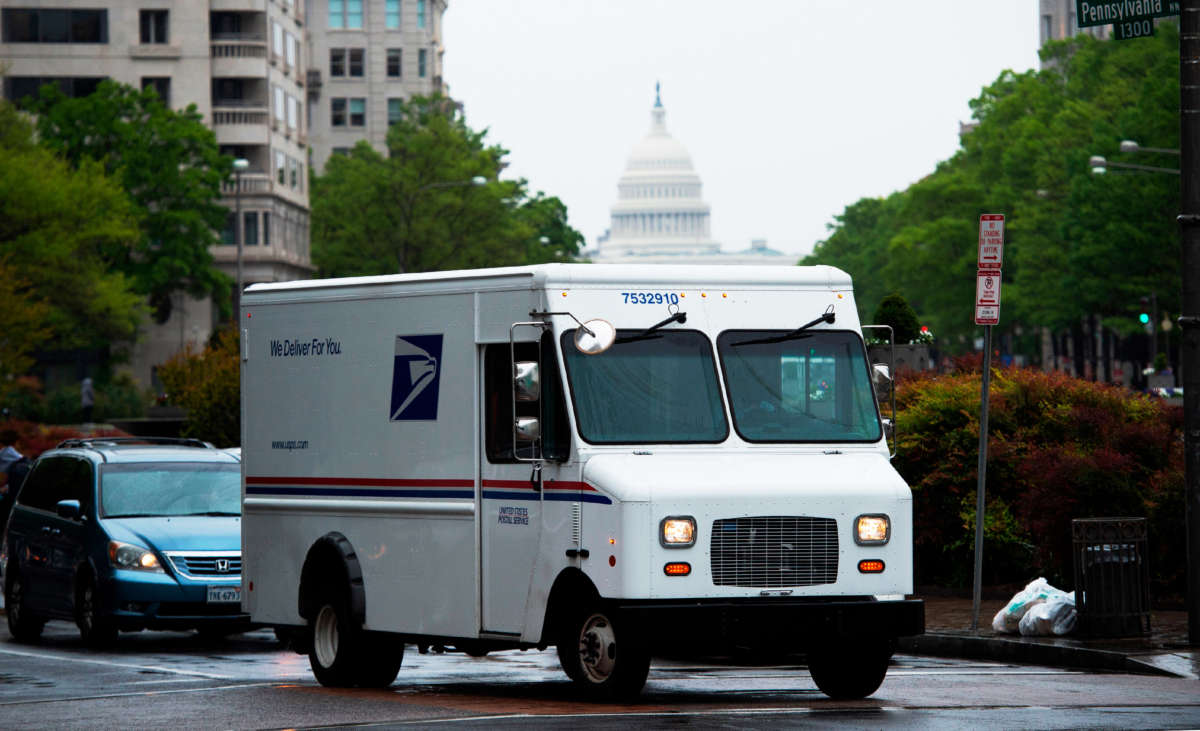Over 50 House Democrats have signed on to a letter urging the White House and House Speaker Nancy Pelosi to consider a proposal to allocate $8 billion in funds for the United States Postal Service (USPS) so that it can get a jump start on electrifying its fleet of mail trucks.
The agency had outlined a plan costing up to $6 billion in February to replace its aging fleet, but only 10 percent of the new vehicles were set to be electric. This ran counter to a pledge by President Joe Biden to electrify the agency’s fleet entirely and baffled Democrats at the time, as well as frustrating environmentalists.
The new proposal from Democrats in Congress would help ease the financial burden on the USPS, which manages its finances largely separately from the federal government, and help reach electrification goals faster.
“To ensure that any federal funding appropriated to the Postal Service for fleet acquisition is used appropriately, we would also include a requirement in legislation that at least 75% of the Postal Service’s new fleet must be electric or zero-emission,” the draft letter reads, per The Washington Post. “Further, we would require the Postal Service to acquire only electric or zero-emission vehicles after 2040.”
The effort, being led by the Oversight and Reform Committee and Transportation Committee chairs — Representatives Carolyn B. Maloney (D-New York) and Peter A. DeFazio (D-Oregon) — is gaining traction in Congress, reports The Washington Post.
According to information from the USPS from February, it plans to commission the creation of 50,000 to 165,000 Next Generation Delivery Vehicles over the next decade. The vehicles will be American-made and would represent a large portion of the 230,000 postal service vehicles, many of which are aging and in dire need of replacement.
Vice reported last year that one USPS truck catches fire every five days. Since 2014, over 400 of the Long Life Trucks, which make up most of the postal service’s current mail delivery fleet have caught fire. Moreover, vehicles in the fleet are two to nine years past their expected life span, the report points out.
Embattled Postmaster General Louis DeJoy has explained that the reason that the agency isn’t planning to make a larger share of the new trucks electric is because of financial constraints. He has said that, in order to get the fleet to where 90 percent are electric vehicles, it would cost the agency more than it can afford — about $3 billion to $4 billion.
But environmental advocates say that it’s harmful to not electrify the vehicles, and that electrifying the trucks — which are used to travel short distances and could charge all night — is an obvious and vital part of helping the country curb its emissions.
Plus, the old trucks are costing the agency a lot already: The Government Accountability Office found in 2019 that maintenance of these trucks costs $2 billion a year.
“Electrifying just 10% of the U.S. fleet, as the postmaster, DeJoy, has suggested, is really shortsighted and not acceptable,” Gina Coplon-Newfield, the Sierra Club’s Clean Transportation for All campaign director, told NPR when the plan was released.
Not only would electrification emit less greenhouse gases, it would also help clean up local communities and be cheaper to operate than the gas-guzzling old trucks. Electric vehicles cost about half as much to go the same distance on average, and are cheaper to maintain, writes David Roberts for Vox. And they don’t emit the harmful pollutants that gas vehicles do, which could help reduce air pollution in every community the post office serves.
Our most important fundraising appeal of the year
December is the most critical time of year for Truthout, because our nonprofit news is funded almost entirely by individual donations from readers like you. So before you navigate away, we ask that you take just a second to support Truthout with a tax-deductible donation.
This year is a little different. We are up against a far-reaching, wide-scale attack on press freedom coming from the Trump administration. 2025 was a year of frightening censorship, news industry corporate consolidation, and worsening financial conditions for progressive nonprofits across the board.
We can only resist Trump’s agenda by cultivating a strong base of support. The right-wing mediasphere is funded comfortably by billionaire owners and venture capitalist philanthropists. At Truthout, we have you.
We’ve set an ambitious target for our year-end campaign — a goal of $250,000 to keep up our fight against authoritarianism in 2026. Please take a meaningful action in this fight: make a one-time or monthly donation to Truthout before December 31. If you have the means, please dig deep.
